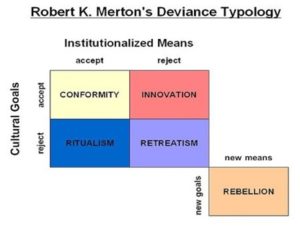Unintended Consequences & Strain Theory
by Bart Binning, Ed. D.
The idea of an “unintended consequence” can be traced back to 1759 and Adam Smith in his treaties The Theory of Moral Sentiments. The Scottish philosopher, and one of the world’s first economists, theorized how chance combined with the both consequences as well as unintended consequences of actions, all combined to produce an invisible hand that benefits human development. Smith argued that each individual pursuing their own ends generates an unintended consequence that provides widespread benefits beyond that individual.
While Smith seems to have first described the concept of unintended consequence, the phrase was popularized by Robert K. Merton (1910-2003), American sociologist who won the 1994 National Medal of Science for developing the concepts of unintended consequences, reference group, role model, and self-fulfilling prophecy. Merton initially popularized the idea of unintended consequences in his 1936 essay, The Unanticipated Consequences of Social Action, where Merton described a wide variety of activities whose results did not go as planned. Merton described a “self-defeating prophecy” where the facts being promoted caused actions that generated an unpredicted result. He used the self-defeating prophecy to suggested that Karl Marx was incorrect is the proposition that as society modernizes, wealth will become more concentrated, causing a majority of society to suffer. Merton described the converse of the self-defeating prophecy as the “self-fulfilling prophecy” which occurred when an originally false proposition turns out to be successful because people believe the proposition, and act accordingly.
Merton wrote that unintended consequences can be roughly grouped into three types based on the type of result:
- Positive – usually referred to as luck, serendipity or a windfall
- Negative – an unexpected result occurring in addition to the desired benefit, ex. Irrigation will tend to increase waterborne diseases; or the covert operations to fund the Afghan Mujahideen during their Russian occupation, contributed to the rise of Al-Queda
- Perverse – a contrary effect to what was originally intended, ex. makes a problem worse, ex. The Streisand Effect – an attempt to hide, remove, or censor a piece of information has the effect of publishing the information – named after a 2003 attempt by Barbara Streisand to suppress photographs of her Malibu residence, thereby generating further publicity.
Merton also developed the developed the Strain Theory in 1938 to conceptualize a systematic approach for understanding and explaining socio-cultural sources of deviate behavior, which became the foundation for several theories of social behavior that are popular today. Strain theory’s basic assumption is that all humans are inherently good-natured and pro-social. The only reason they act differently (or not pro-socially) is when society fails them. This failure leads to a build-up of feelings of frustration, anger, stress, and depression, or strain.
According to the theory, the strain an individual experiences because of social and cultural factors can have five responses. These responses are adaptations to the strain and are a result of an interaction between:
- An individual’s desire to accomplish socially approved goals, and
- An individual’s access/usage of socially accepted means to achieve these goals
The deviant behavior comes when an individual does not want to accomplish socially approved goals or does not use socially accepted means to achieve those goals. An example being in 1929 Secretary of State Henry Stimson closed down the war department’s cryptanalysis department by saying “Gentlemen do not read each other’s mail.” The impact of the decision on US defense and intelligence activities was unintended.
Merton’s typology of the modes of adaptation is based on the concept of deviance, which can be defined as doing something that isn’t culturally accepted or, at the least, is culturally frowned upon. Deviance is doing something out of the norm and can range from slightly tweaking the socially/culturally accepted norms to outright non-conformation.
Conformity: The mode of adaptation in which an individual chooses to achieve culturally accepted goals via institutionalized means. Conformists are those who choose to play by the rules. They are the ones who form a major chunk of society. Without their majority, a society would tend to move towards a state of disorder, confusion, and disorganization.
Innovation: The mode of adaptation in which an individual desires to achieve culturally accepted goals but does so without following the institutionalized means of achieving them. Innovators, like conformists, are motivated to strive for socially-valued goals but tend to do it in their own way while rejecting the approved means of achieving them. They can adopt such an approach because of various strains, such as financial strains, the strain of being discriminated in society, or, and not limited to, the strains of having marginal or no access to the socially-approved means of achieving culturally-acceptable goals.
Ritualism: The mode of adaptation in which an individual has lost his interest in striving for the socially accepted goals but is satisfied in running through the rituals of working within the institutionalized means. Ritualists are those who have given up on the idea of competing for higher goals and achievements and are content with the chore of being in an institutionalized system and working in it. They no longer desire to climb up the social ladder by competing for culturally-valued goals and are happy with the stability provided to them by functioning as members of an institutionalized system.
Retreatism: The mode of adaptation in which an individual rejects both the idea of achieving culturally-approved goals as well as functioning within the framework of socially-approved institutionalized means. Retreatists are those who reject the ideas of achieving socially desired goals or of functioning as a productive member of an institutionalized system. They generally tend to do so to escape the constructs of both the culturally-approved goals and the legitimate means of achieving them.
Rebellion: The mode of adaptation in which an individual rejects both the culturally-acceptable goals as well as the institutionalized means of achieving those goals. However, while rejecting both components, they replace them with new goals and means of achieving them. This replacement of goals and means is what separates rebellion from retreatism. Reminiscent of the terrorism that followed the Arab Spring in the Mideast. Rebels, therefore, are people who no longer desire to achieve culturally acceptable goals via legitimate means. They find their niche in doing something ‘they’ think is appropriate using means that they think should be used. Rebels are those that function outside Merton’s construct altogether.
Which brings us to the question, what are our society’s Cultural goals and how do we communicate those goals to our children? Historically, this communication was done by the religion through the telling stories describing the myths that signified what we valued. With the rise of public education during the middle of the 19th century, the focus changed from religion, where it was said that the purpose of public education was to educate our children into becoming independent, self-reliant adults inculcated with the values of society. But towards the end of the 20th century, we started questioning the truths of our forefathers, by questioning the validity of the myths we told our children to describe values we upheld. (Ex., as a child, George Washington could not have thrown a coin across the Potomac because at that point in the myth, the Potomac was a mile wide. They ridiculed the myth that George Washington did not tell a lie when he chopped down the cherry tree.)
Is it worth the unintended consequence of promoting the absolute truth over the values expressed by myths?


